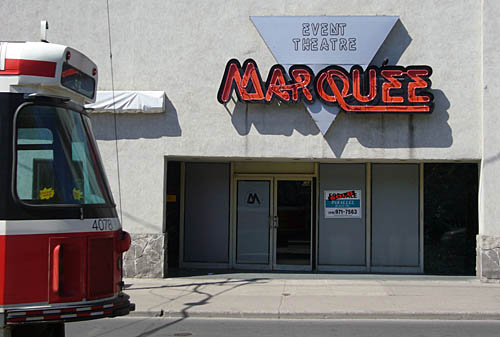Sometimes you gotta be in the right place at the right time.

Sometimes you gotta be in the right place at the right time.

The foregoing posting appeared on Joe Clark’s personal Weblog on 2007.05.20 10:39. This presentation was designed for printing and omits components that make sense only onscreen. The permanent link is: https://blog.fawny.org/2007/05/20/pumpcrane/
I’ve been sitting on this for months, and it still bugs me. Fine print at the Transit Camp site declared the following:
By agreeing to participate in Toronto Transit Camp, you are agreeing to the Transit Camp Pledge. Part of that Pledge is that all content created at the event will be covered by a Creative Commons Attribution–NonCommercial–ShareAlike license.
I made no such agreement or pledge. I also made no copyrightable works at the event that could be covered by any such pledge. (I would be interested to hear someone make the case that photographs taken by my own camera fall into that category.)
I believe I am the only person who is interested in copyright reform who does not support Creative Commons. (Yes, I’m the one.) Creative Commons is based on a number of flawed premises (e.g., you cannot be harmed by “freely” permitting others to use your work); all the wrong people are signing up (the really useful and attractive work belongs to corporations, not bloggers); there are intractable conflicts with Canadian law (like droit moral); it’s legally untested; rights are given away forever; and, at root, you don’t need it. You can specify your own set of rights and permissions quite easily, and even without the fair-use doctrine that copyleftists are always calling for, most “users” already have more than enough room to do what they want under existing law.
Also importantly, Big Daddy CC, Lawrence Lessig, took an important case to the U.S. Supremes and totally blew it. Are you following the wrong leader?
As with other sets of rights and permissions, including the ones already written into law, you’re free to choose Creative Commons. I just don’t think most people really know what they’re getting into. There’s so much discussion about Creative Commons on blogs that a form of peer pressure has emerged. If you opt out, you must be as bad as Disney.
Well, I opted out and I’m not as bad as they are. I’ve suffered for copyright and you haven’t. And I have an excellent copyright lawyer. I know what I’m doing. Do you?
Now, this Transit Camp business seemed like the worst form of peer pressure. In fact, it was outright coercion: Agree to sign away your rights (all Creative Commons licences involve signing away rights) or you can’t come to our party.
If you really believe in copyright reform, then you arrived at that belief by observing that the existing régime is too restrictive and is biased in favour of multinationals. The Transit Camp régime was too restrictive and was biased against every participant.
The fine print attempts to explain the policy thus:
All the online, audio, video and physical content produced will be delivered to the TTC for their review and consideration as they pursue their plans for the future.
You’re handing your work over to the TTC. Or rather, some unnamed person or persons will take it from you and give it to somebody else.
These artifacts will also be used to mount a planned exhibition at a future community gallery show. Your work will always be your work, with full credit.
Except that works cannot actually be hung in a gallery without permission. (The copyright holder has the sole right to control exhibition of a work. That would be you.)
In effect, this means the TTC can benefit from these ideas, bloggers can blog about it, the material can be shared and distributed widely. But as soon as someone wishes to use the material outside of the terms of the licen[c]e (i.e. make money with it or make it proprietary in some way), they must contact the copyright holder to negotiate terms of use.
In practice, this really means that the presumptive winners of the contract to redesign the TTC Web site, Jay Goldman and Radiant Core, can use your ideas as part of their pitch. Besides, Transit Camp was pretty much Jay’s idea. Beautiful! Mickey couldn’t have set it up better.
If any of you think you can get away with nonsense like this at future conferences, be advised now that I will show up, intentionally create a copyrightable work, and sue you if you try to use it in any way permissible under Creative Commons but impermissible under existing law. I’ve taken down bigger adversaries than you, and I’ll laugh while I’m doing it. It would be just as unwise to use the foregoing as a pretext to exclude me from an event. You’re conference organizers, not pirates. Presumably.
Fun little exercise: Find and cite any and all of my own uses of Creative Commons–licensed work.
The foregoing posting appeared on Joe Clark’s personal Weblog on 2007.05.15 17:29. This presentation was designed for printing and omits components that make sense only onscreen. The permanent link is: https://blog.fawny.org/2007/05/15/anticommons/
Rick Poynor is a design critic of approximately my generation, with an output rivalled only by Steven Heller. Even though he’s made sense exactly twice in his career (in Helvetica and in a review of different covers of Ballard’s Crash), he’s a big fish in the small pond of graphic-design criticism. The other critics – all five of them – really care what he thinks. But when they are gone, so will memories of Poynor be, because not only is he on the wrong side of history, he has opted out of the defining medium of the 21st century. And, like an aging chanteuse with too many farewell tours, he can’t keep from repeating himself: First he quits the Design Observer blog, dismissing the entire enterprise, then he used a column in Print magazine to do the latter all over again.
Why are we letting Rick Poynor set the terms of the debate? Why are we even having a debate about Poynor-style unreadable, unillustrated, turgid, overintellectualized design writing on the one hand and design blogs on the other? [continue with: Antipoynorism →]
The foregoing posting appeared on Joe Clark’s personal Weblog on 2007.05.14 14:22. This presentation was designed for printing and omits components that make sense only onscreen. The permanent link is: https://blog.fawny.org/2007/05/14/antipoynorism/
I still cannot get used to calling the Ontario College of Art “OCAD” even years after the addition of & Design to its official name. For old-timers, OCAD is and shall always be “OCA.” (Old-timers have all experienced a long string of complete nonresponses to applications to teach there. And those of us familiar with the Banff Centre have little confidence in the recently-installed president, Sara Diamond.)
But this is about the new generation. Every year, OCA papers nearly all its walls (and, with the new sky-high addition, there are a lot of walls) with exhibits by graduates. I initially planned to cruise by with my esteemed colleague half an hour before closing on Friday night. I ended up there on Saturday morning, didn’t leave until well into the afternoon, and ended up so wiped out I had to have a three-hour nap and stayed in on a Saturday night. That’s dedication!
I have photos up on Flickr. [continue with: OCAD grad show 2007 →]
The foregoing posting appeared on Joe Clark’s personal Weblog on 2007.05.13 17:57. This presentation was designed for printing and omits components that make sense only onscreen. The permanent link is: https://blog.fawny.org/2007/05/13/ocadgrad2007/
Located on one of Toronto’s quantum-state strips – between the two Gerrards and Coxwell.

The faux-neon is a nice touch, as is the ancient Letraset typeface, Quicksilver. The whole motif must have gone over well when the leather queens held their formal there.
The foregoing posting appeared on Joe Clark’s personal Weblog on 2007.05.11 17:23. This presentation was designed for printing and omits components that make sense only onscreen. The permanent link is: https://blog.fawny.org/2007/05/11/eventtheatre/

The foregoing posting appeared on Joe Clark’s personal Weblog on 2007.05.08 16:38. This presentation was designed for printing and omits components that make sense only onscreen. The permanent link is: https://blog.fawny.org/2007/05/08/bathurstlift/
Not quite an only-in-Toronto sighting, but the chance viewing of a family of geese hanging out next to the sidewalk is at least more likely here.

Sorry it isn’t LOLGEESE.
The foregoing posting appeared on Joe Clark’s personal Weblog on 2007.05.07 16:26. This presentation was designed for printing and omits components that make sense only onscreen. The permanent link is: https://blog.fawny.org/2007/05/07/goslings/
By, of all people, Camille Paglia (q.v.). It’s been something of a Paglia Week here, given that we also rewatched Basic Instinct with her audio commentary activated.
Writing in Communication and Cyberspace: Social Interaction in an Electronic Environment (Strate et al., second edition, 2003), pp. 266–275:
[In 1991,] a visitor from Boston approached me at the podium
Wait. Camille Paglia would ever allow such a thing? If you mail anything larger than a Nº 10 envelope to her offices, it gets returned with a stamp reading PACKAGES NOT ACCEPTED. She’s gonna let people rush the podium?
Anyway, it’s her story.
and asked, “Are you aware that you’re all over the Well?” “What is the Well?” I asked, completely baffled.
A week later, a packet arrived at my office in Philadelphia.
Wait. How? Wasn’t it sent back?
I brandished the thick printout at my colleagues…. “Look – a person in Boston is arguing about my ideas with someone in Tennessee, and they’re both arguing with someone else in San Francisco!”
Well, that would be the expected outcome for anyone from there.
My commitment to the Internet is partly inspired by gratitude: It was the Well, I later saw, that had helped spread the word about my controversial and long-delayed first book, a 700-page tome that its publisher… did not expect would find a wide audience. In an era of political correctness…. the Internet was operating like an invisible subterranean resistance movement. […]
[T]he Internet has caused a tremendous cultural shift whose most profound impact has been on young people. It will take another 30 years before the Internet’s effects are clearly understood. The computer has literally reshaped the brain[s] of those who grew up with it, just as television and rock music reshaped the brains of my Baby Boom generation and made our thinking so different in form and content from that of writers and critics born just before World War II. […]
Throughout the 1990s, elite universities inflicted a cruel cognitive dissonance on their humanities students, who were forced to read antiquated French and German theory… while cyberculture was exploding all around them…. The young knew perfectly well that the language of the future was now the computer and the Web. […]
I submit that the stop/start rhythm of a half-century of commercial TV viewing was Americans’ basic training for Internet communication…. The jump or truncation is an American specialty…. The puzzling failure of humanities professors to contribute in any substantial way thus far to the leading Webzines stems, I conjecture, from their long ambivalence about TV[,] retreating to the online special-interest groups where they resume the same professional conversation they have at conferences. […]
Some academics may feel that Internet writing, like the TV image, is evanescent, but the opposite is true. Ever since it switched from live to tape, TV is the great medium of the rerun…. so with the Web where not only do the search engines net up every obscure, years-old crackpot like debris from the sea floor but where, in the best-organized Web sites, all past articles are miraculously available by pushbutton access in their archives.
Unlike, say, essays on cultural studies and the Internet, which must be painstakingly ordered via interlibrary loan and excerpted so that they can actually be read on the Internet, if only in part. (By the way, Paglia consistently says “Internet” when she means “Web.” The pre-Web Well is a mere footnote to her history here.)
In writing for the Web, I’ve also found that text must be visually designed: Its ideal basic architecture consists of sharply-delineated, single-spaced paragraphs…. I also choose vocabulary that looks interesting on the page, which usually means juxtaposing blunt Anglo-Saxon nouns and high-action verbs with polysyllabic Greco-Roman abstractions…. The text should be palpable and not just a remote stream of cyphers on a glassy wall. […]
While cast in more-lucid prose, the leading [print] articles on literature and culture… are often amazingly verbose, taking pages to make simple points: It’s as if the thought processes of the authors and editors remain untouched by the media revolution of the past century…. Organic also is the Webzine’s ability to correct factual errors or typos in already-posted articles – a luxury unavailable to print journalists, who are stuck forever with embarrassing mistakes (as when copy-editors fresh from college maddeningly introduce grammar errors at deadline).
Paglia then cites the example of the death of Princess Diana, which Salon was able to cover wall-to-wall before the British had even gotten up in the morning. (“And in the process, Salon scooped and humiliated its rival, Slate, which had closed its east-coast offices for the last week of August before Labo[u]r Day [its staff presumably decamping to the Hamptons].”)
Oh, and incidentally, if you’re tired of putting up with Salon’s antediluvian interstitial ads just to read Camille Paglia’s column, be aware that a variation of the Salon cookie trick still works: Visiting salon.com/news/cookie756.html before any page resets the clock and eliminates the intrusion of ads.
The foregoing posting appeared on Joe Clark’s personal Weblog on 2007.05.05 15:49. This presentation was designed for printing and omits components that make sense only onscreen. The permanent link is: https://blog.fawny.org/2007/05/05/newfrontier/
Your options are:
Simon Pegg, actor: Strawberry blond only in the summer. Or when wearing a “stab vest.” Or both.


(Hot Fuzz, by the way? ★★★★)
Another “actor,” this one “adult,” with a nom de porno so ridiculous I can’t bring myself to write it: Provably not ginger, but photographs that way (a new concept), complete with defining blepharoplastable eyelids.


Make your selection now.
The foregoing posting appeared on Joe Clark’s personal Weblog on 2007.05.04 15:18. This presentation was designed for printing and omits components that make sense only onscreen. The permanent link is: https://blog.fawny.org/2007/05/04/pegg-mvf/